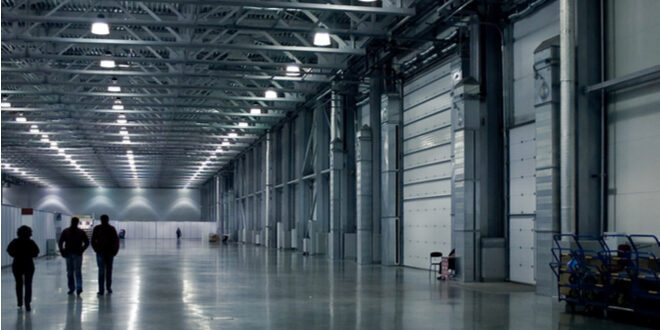Shorter idling times and roofs that are able to accommodate solar panels are among regulations the city has put in place. Some of the restrictions are tougher than those imposed by larger jurisdictions.
It just became a little more difficult to operate a warehouse-distribution facility in Fontana.
In January, the city council unanimously adopted regulations that apply to all warehouse-distribution facilities within the city, regulations mostly intended to improve air quality.
Specifically, the new rules add environmental and building standards to warehouse-distribution facilities. In some instances, those, standards are stricter than county, state and federal regulations, according to city officials.
The new regulations include:
- A three-minute limit on idling, with signs at every warehouse-distribution operation notifying drivers of that restriction;
- Facility operators must put in place, and enforce, a truck routing plan;
- Signs and pavement markers are required to identify a facility’s internal circulation pattern;
- Plug-in outlets at all loading docks that serve refrigerated trucks in order to prevent unnecessary idling;
- Signs with contact information to reach either a representative of the building operator or the South Coast Air Quality Management District, which enforces local air pollution restrictions;
- Zero emissions requirement for all on-site equipment, and all warehouse-distribution facilities must have roofs that will accommodate solar panels;
- At least 10 percent of all parking spaces must accommodate all electric vehicles.
Those restrictions were adopted in part to comply with a regulation adopted by the air quality management district nearly one year ago. Its Warehouse Indirect Source Rule requires warehouses larger than 100,000 square feet to reduce nitrous oxide and diesel emissions, and they must also prohibit emissions that cause injury or that disturb a substantial number of people.
Recently, because it has accumulated so many logistics facilities over the years, Fontana has been a little tougher in approving those type of projects. The new ordinance codifies a lot of those tougher standards, said Phil Burum, deputy city manager.
“We’ve done a lot of conditional approvals on these projects lately, and we’re trying to get away from that,” Burum said. “But some of what’s in the new ordinance are things we’ve been doing for awhile.”
Ultimately, the owners of the warehouse-distribution facilities will be responsible for enforcing the new regulations.
During the past 25 years or so, the Inland Empire has been overwhelmed with warehouse-distribution projects, so much so that the region has come to be known as the warehouse of the western United States.
That trend probably reached its peak in the summer of 2015, when Moreno Valley approved the World Logistics Center, a 40.6 million square foot warehouse-distribution development on the city’s east side.
Expected to be completed by 2030, the project will be one of the largest of its kind in the world, taking up approximately 10 percent of Moreno Valley’s land mass.
But no sooner had the World Logistics Center been approved than it become the focus of a major legal battle, in which multiple environmental groups sought to limit the project’s environmental impact.
That effort led to a $47 million settlement last August between the environmentalists and Highland Fairview in Moreno Valley, the project, which will allow development of the World Logistics Center to move forward.
Recently there has been some pushback against the logistics industry in general, from citizens and environmental groups who are concerned about traffic, noise and air pollution.
That, in turn, has led several municipalities to take action, including Riverside and Colton, both of which passed moratoriums regarding the construction of warehouse-distribution facilities.
“There has been some opposition, but in our view it’s absolute NIMBYism,” said Bill Blankenship, spokesman for the Inland Empire chapter of NAIOP,” an advocacy group for developers, owners and investors of office, industrial, retail and mixed-use real estate. “It doesn’t solve anything.”
Opponents of warehouse-distribution facilities overlook how important that industry is to the Inland Empire, and that logistics is only going to get bigger, Blankenship said.
“People don’t shop at the mall like they used to, they prefer to shop online, and that means more warehouses will have to be built,” Blankenship said. “We still have land, so we’re going to get more logistics. There’s no way to change that.”
About one dozen Inland Empire cities during the past two years have tried to rein in warehouse-distribution centers by passing ordinance’s similar to Fontana’s, but none of them go quite as far as that ordinance, according to Blankenship.
“Because of the idling restrictions – three minutes instead of the usual five minutes – and the solar panel requirements – I have to say that Fontana’s ordinance is tougher to comply with,” Blankenship said. “They have things that other cities don’t have.”
Blankenship, former head of the Riverside County chapter of the Building Industry Association of Southern California, was part of the NAIOP team that helped Fontana write the ordinance.
“We understand the pressure a city is under, and we’re glad that they didn’t pass a moratorium,” Blankenship said. “We believe moratoriums are a bad idea because they send the wrong message to the business community.”
That Fontana chose to adopt in some instances tougher restrictions than those required by the U.S. government or the state of California shows how serious the city is about clean air and and reducing traffic, Burum said.
He acknowledged that Fontana’s new ordinance, codified or not, is tougher than some state and federal regulations regarding warehouse-distribution centers, and that some developers and operators will have trouble complying with it.
It could also keep some future developers from locating their logistics project in Fontana, but the city appears willing to pay that price.
“One person who runs a 200,000-square-foot facility told me the ordinance will add about $1 million a year to his operation,” Burum said. “That is a lot of money, and we have gotten some pushback. But it is what it is.”
 IE Business Daily Business news for the Inland Empire.
IE Business Daily Business news for the Inland Empire.


